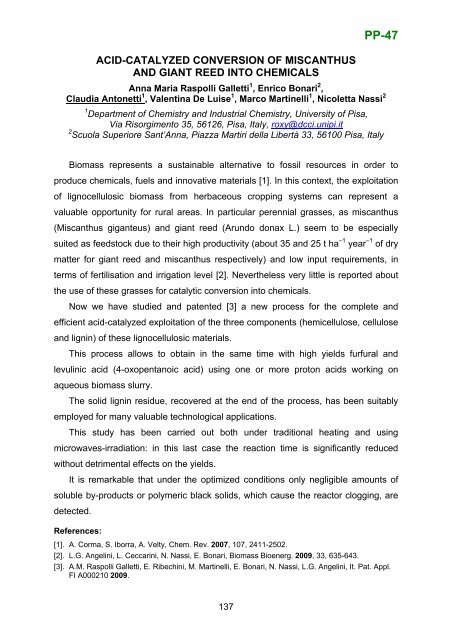PP-46PROBLEM OF RECEPTION OF ANTIMATTER BY MEANSOF ENERGY OF THE SUNProkopev E.P.A.I. Alikhanov <strong>Institute</strong> for Theoretical and Experimental Physics, str. BolshayaCheremushkinskaya, 25, Moscow, <strong>Russia</strong>, 117218, e-mail: epprokopiev@mail.ruThe big interest represents an possibility <strong>of</strong> reception <strong>of</strong> intensive streams <strong>of</strong>positrons (probably and other antiparticles) at reorganization <strong>of</strong> physical vacuum instrong fields (for example, in an electric field <strong>of</strong> modern super-power laser beams)and on accelerators (http://www.popmech.ru/part/?articleid=4803&rubricid=3). Speechcan possibly go about creation <strong>of</strong> space solar factories on the Moon or asteroids, etc.with use <strong>of</strong> the transformed energy <strong>of</strong> radiation <strong>of</strong> the Sun to electric energy and uses<strong>of</strong> a space for manufacture and storages <strong>of</strong> positrons [1-3]. The essence <strong>of</strong> a methodshould consist in reception by means <strong>of</strong> the transformed energy <strong>of</strong> the Sun onaccelerators or any other methods <strong>of</strong> streams <strong>of</strong> fast positrons with their subsequentdelay up to temperatures <strong>of</strong> the order 0,5 K in some closed area <strong>of</strong> a space. Thus,very significant stocks <strong>of</strong> positrons could be created. Gathering <strong>of</strong> such positrons inmagnetic traps in conditions <strong>of</strong> a space can become rather effective method <strong>of</strong>accumulation <strong>of</strong> antimatter by means transformations <strong>of</strong> energy <strong>of</strong> the sun.On a modern level <strong>of</strong> development <strong>of</strong> technologies about lots <strong>of</strong> receivedantimatter to speak it is not necessary. Besides this process <strong>of</strong> reception is very dear.Therefore probably really to speak only about tens or hundreds nanograms receivedantimatter. This quantity <strong>of</strong> antimatter, apparently, would suffice for creation <strong>of</strong> spacevehicles (SV) with the sizes in nano-or a micron range. This fantastic assumption isnot deprived sense in a context <strong>of</strong> modern development <strong>of</strong> nanotechnologies in theWorld. All the sizes long devices and details such SV should not exceed the sizes <strong>of</strong>nano- and micron ranges.[1]. E.P.Svetlov-Prokop’ev // Materials <strong>of</strong> the international conference. Ed. E.I.Artamonov. М.: <strong>Institute</strong><strong>of</strong> problems <strong>of</strong> management <strong>of</strong> the <strong>Russia</strong>n Academy <strong>of</strong> Science. - 2008. P.100,101.[2]. E.P.Prokop’ev. Possible space technologies <strong>of</strong> the future and a problem <strong>of</strong> technical progress.Materials <strong>of</strong> the Third Belarus space congress. On October, 23-25 rd 2007, Minsk, Belarus.Minsk: Publishing house <strong>of</strong> the Incorporated institute <strong>of</strong> problems <strong>of</strong> computer science NAS <strong>of</strong>Belarus, 2007. P.383-389. http://www.uiip.bas-net.by/kosmos3/sec10.html,http://www.prokopep.narod.ru[3]. Svetlov-Prokopyev. / About a problem <strong>of</strong> physics and chemistry <strong>of</strong> antisubstance: opportunities <strong>of</strong>research <strong>of</strong> properties, search in the Universe, synthesis and applications // In кн.: « Actualproblems <strong>of</strong> modern physics ». Materials <strong>of</strong> the All-<strong>Russia</strong> remote scientifically-practicalconference with the international participation. <strong>Russia</strong>, Krasnodar, on June, 5th, 2008. Krasnodar:КGU, 2008. P.15-30.136
ACID-CATALYZED CONVERSION OF MISCANTHUSAND GIANT REED INTO CHEMICALSPP-47Anna Maria Raspolli Galletti 1 , Enrico Bonari 2 ,Claudia Antonetti 1 , Valentina De Luise 1 , Marco Martinelli 1 , Nicoletta Nassi 21 Department <strong>of</strong> Chemistry and Industrial Chemistry, University <strong>of</strong> Pisa,Via Risorgimento 35, 56126, Pisa, Italy, roxy@dcci.unipi.it2 Scuola Superiore Sant’Anna, Piazza Martiri della Libertà 33, 56100 Pisa, ItalyBiomass represents a sustainable alternative to fossil resources in order toproduce chemicals, fuels and innovative materials [1]. In this context, the exploitation<strong>of</strong> lignocellulosic biomass from herbaceous cropping systems can represent avaluable opportunity for rural areas. In particular perennial grasses, as miscanthus(Miscanthus giganteus) and giant reed (Arundo donax L.) seem to be especiallysuited as feedstock due to their high productivity (about 35 and 25 t ha –1 year –1 <strong>of</strong> drymatter for giant reed and miscanthus respectively) and low input requirements, interms <strong>of</strong> fertilisation and irrigation level [2]. Nevertheless very little is reported aboutthe use <strong>of</strong> these grasses for catalytic conversion into chemicals.Now we have studied and patented [3] a new process for the complete andefficient acid-catalyzed exploitation <strong>of</strong> the three components (hemicellulose, celluloseand lignin) <strong>of</strong> these lignocellulosic materials.This process allows to obtain in the same time with high yields furfural andlevulinic acid (4-oxopentanoic acid) using one or more proton acids working onaqueous biomass slurry.The solid lignin residue, recovered at the end <strong>of</strong> the process, has been suitablyemployed for many valuable technological applications.This study has been carried out both under traditional heating and usingmicrowaves-irradiation: in this last case the reaction time is significantly reducedwithout detrimental effects on the yields.It is remarkable that under the optimized conditions only negligible amounts <strong>of</strong>soluble by-products or polymeric black solids, which cause the reactor clogging, aredetected.References:[1]. A. Corma, S. Iborra, A. Velty, Chem. Rev. 2007, 107, 2411-2502.[2]. L.G. Angelini, L. Ceccarini, N. Nassi, E. Bonari, Biomass Bioenerg. 2009, 33, 635-643.[3]. A.M. Raspolli Galletti, E. Ribechini, M. Martinelli, E. Bonari, N. Nassi, L.G. Angelini, It. Pat. Appl.FI A000210 2009.137
















